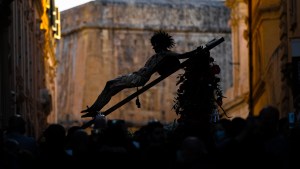Lenten Campaign 2025
This content is free of charge, as are all our articles.
Support us with a donation that is tax-deductible and enable us to continue to reach millions of readers.
In a moment of deep spiritual and cultural significance, Pope Francis blessed the titular statue of St. Cajetan from Ħamrun, Malta, at St. Peter’s Basilica in Rome. The statue’s journey to the heart of the Catholic Church marked the 500th anniversary of the Theatine Order, founded by the saint himself.
The Pope met with the representatives of the Order on September 14, just after his return from his long trip to Oceania and Asia. The Holy Father showed his joking spirit as he began his address with a quip about the Theatines and his own spiritual family, the Jesuits.
He noted the significance of the saint’s time in Rome:
I am pleased to meet you on the fifth centenary of the solemn vow of St. Cajetan of Thiene and his first companions, made here, in this Basilica [of St. Peter’s], on September 14, 1524. History tells us that the Theatines had some differences with the Jesuits, but I don’t believe it! Let us go forward.
The blessing of the statue, attended by a large group of Maltese pilgrims, brought a unique fusion of Maltese devotion and Vatican reverence to the streets of Rome.
The statue was carried from St. Peter’s Basilica, as bands from the Maltese town of Ħamrun filled the air with music. The bands, representing the Għaqda tal-Mużika San Gejtanu and Soċjetà Mużikali San Ġużepp, accompanied the procession as it moved towards the Church of Santa Maria di Transpontina.
This Carmelite-run church, located on Rome’s famous Via della Conciliazione, served as the next stop in the pilgrimage of the revered statue.
The blessing by Pope Francis was a key highlight of the day. As read in the Times of Malta, after a heartfelt prayer, the Pope extended his hand in blessing, honoring both the Maltese people’s devotion and the legacy of St. Cajetan.
For many of the nearly 1,000 pilgrims from Ħamrun who made the journey to Rome, this was a once-in-a-lifetime experience, connecting their town’s cultural heritage to the broader Catholic tradition.
A historic pilgrimage
The St. Cajetan statue’s journey to Rome began in late August. Carefully transported by sea and driven across Italy, the figure arrived at its first destination, the Basilica of San Andrea della Valle.
On Friday, it was moved to St. Peter’s Basilica, where it was placed close to the altar, awaiting the Pope’s blessing on Saturday morning.
The moment the statue emerged from St. Peter’s, Maltese pilgrims burst into cheers and applause, a moment captured and shared widely on social media. Footage of the day shows the streets of Rome filled with music, as the bands from Ħamrun led the procession with joyful tunes, adding a distinctly Maltese flavor to the event.

After the blessing, the pilgrimage continued to the Church of Santa Maria di Transpontina. Following this, the statue was returned to the Basilica of San Andrea della Valle, before it would eventually make its way back to Ħamrun, where it resides in the parish church dedicated to St. Cajetan.
The Maltese devotion to St. Cajetan
St. Cajetan holds a cherished place in the hearts of the Maltese, particularly in the town of Ħamrun, where his feast day is celebrated with fervor each August 7. The statue resides in the grand parish church of Ħamrun, an architectural masterpiece that shows the deep spiritual ties of the town’s inhabitants to their patron saint.
For the people of Ħamrun, the Pope’s blessing of their titular statue in Rome was an extraordinary honor. Another article, also published by the Times of Malta, claims archpriest Walter Cauchi described the event as “a golden opportunity for the Maltese people” to honor their saint and showcase their faith on the international stage.
Indeed, the day was a celebration of Malta’s cultural heritage within the broader Catholic world.
St. Cajetan’s legacy
Born in 1480 in Italy, St. Cajetan lived a life of deep spiritual devotion and social reform. He founded the Theatine Order during a period of great upheaval in the Church, focusing on addressing the spiritual needs of the faithful while also providing practical support for the poor. His establishment of hospitals and a bank offering interest-free loans — one of the first of its kind — speaks to his commitment to both spiritual and social welfare.

An ambassador’s vision
This remarkable event was made possible in part through the efforts of Malta’s Ambassador to the Holy See, H.E. Frank Zammit.
Ambassador Zammit, working closely with the Superior General of the Theatine Order, H.E. Fr. Salvador Rodea Gonzalez, and other key figures in Malta, ensured that the statue’s presence in Rome would be a centerpiece of the 500th anniversary celebrations. The cooperation of Maltese church authorities, led by Archbishop Charles J. Scicluna, also played a vital role in bringing this historic event to fruition.



